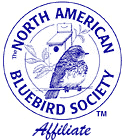
“Bringing Back Bluebirds for Future Generations”
History of the Bluebird Recovery Program
Bluebird numbers declined dramatically during the past century. Loss of habitat and suitable nesting sites and competition with non-native house sparrows and starlings were the main reasons. In the 1960’s Dick and Vi Peterson were concerned about the decline of bluebirds in Minnesota and they began building nest boxes. Dick began recording detailed observations and was constantly altering his nest box design and improving his methods of controlling parasites and predators.
In 1978 the Audubon Chapter of Minneapolis (AOM) was asked to fund an Eagle Scout project. A young Boy Scout knew about Dick Peterson and about his bluebirds and wanted to work with the Petersons to set up a trail. 12 members of the chapter became interested and formed a little bluebird club to monitor the trail. In 1979, their first year, they recorded 22 fledglings.
After a newspaper article appeared featuring his longtime bluebird work and his unique nest box, Dick Peterson went to the Audubon Chapter of Minneapolis asking for help in answering hundreds of letters and nest box plan requests he had received. The Bluebird Recovery Program (BBRP) was quickly organized as a committee of The Minneapolis Chapter of the National Audubon Society with Dorene Scriven as the chairperson. In 1982 the first bluebird conference was held and 50 people came. Originally part of the Conservation Committee, BBRP eventually became financially independent, but still retained the non-profit status of the Audubon Chapter. BBRP has also had a close association with the Minnesota DNR Nongame Wildlife Program and its director Carrol Henderson. In 1988 the DNR funded a survey of bluebird trails. Through joint restoration efforts Minnesota now has one of the most successful bluebird recovery projects in the nation. In 1988, with financial help from the DNR Nongame Wildlife Fund, the first edition of “Bluebird trails; a guide to success” written by Dorene Scriven was published. Another pioneer in bluebird trails is Steve Gilbertson of Aitkin MN who developed the Gilwood wood nest box and the Gilbertson PVC nest box.
At the time of organizing back in the 1970s, BBRP was the first state bluebird organization in the nation. As a result, its membership rose to 2300. When many other states created their own bluebird clubs or programs, many joined their own state organization with BBRP’s encouragement. The current membership still includes individuals outside of Minnesota, primarily in Wisconsin and Iowa.
In October 2018, after its 40-year affiliation with AOM, BBRP began the process of becoming its own independent non-profit 501(c)(3) organization. In 2019 the transition was successfully completed under the official name of Bluebird Recovery Program of Minnesota. We are looking forward to our next 40 years “bringing back bluebirds for future generations!”
Organization
The volunteer BBRP Board, along with guiding the policies and decisions of the organization, hosts an Annual “Expo” Conference where hundreds of Bluebirders gather to share information and attend interesting and educational birding related sessions. County Coordinators are available to assist and advise Bluebirders throughout the state. Their contact information can be found on our website here, along with information on how to report yearly trail monitoring results, how to become a BBRP member and many helpful tips to improve bluebirding successes.
Advantages of Becoming a Member
Membership in the Bluebird Recovery Program includes: an initial Information packet containing a full color Trial Guide, Top Ten Tips including colored Nest Guide, Record Keeping booklet, Pole Assembly instruction sheet, yearly Report Form and quarterly Newsletter. Membership contributions are tax deductible.
BBRP is an affiliate of the North American Bluebird Society (NABS) and cooperates with the Nongame Wildife Program of the Minnesota Department of Natural Resources.


